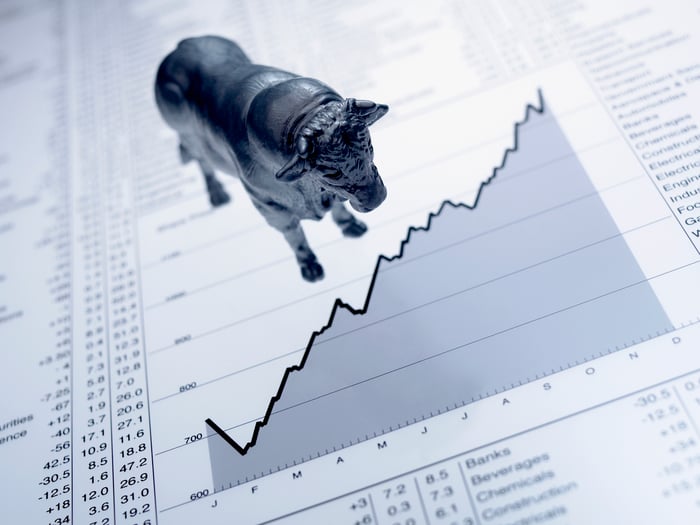When it comes to investing on Wall Street, patience pays off.
At no point between 1919 and 2020 have the rolling 20-year total returns (i.e., including dividends) for the benchmark S&P 500 (^GSPC 1.26%) been negative, according to a recent report from Crestmont Research. In other words, as long as you're willing to hold your investments for a long time, it doesn't matter if you buy at the market bottom, at the peak, or somewhere in between -- you'll almost certainly make money.
The thing is, there are a lot of approaches to make money that'll work. A lot of folks choose to buy stakes in individual companies. However, not everyone has the time to devote to research or the stomach to handle a lack of investment diversity. That's where exchange-traded funds (ETF) come in.

Image source: Getty Images.
An ETF is a security that trades like a stock but holds stakes in dozens or potentially hundreds of stocks or bonds. It gives investors their choice of instant diversification or concentration. Most important, ETFs are often less volatile than owning individual companies.
If you have $5,000 that's ready to invest right now and want to put the power of ETFs to work in your portfolio, you should consider buying the following three surefire ETFs.
AdvisorShares Pure U.S. Cannabis ETF
Marijuana projects as one of the fastest growing industries in North America this decade. But make no mistake about it, the U.S. is the epicenter of this growth. That's why it makes perfect sense for investors to concentrate on U.S. marijuana stocks, which is exactly what the AdvisorShares Pure U.S. Cannabis ETF (MSOS -1.72%) does.
The AdvisorShares Pure U.S. Cannabis ETF holds stakes in 31 companies, as of last week, with the vast majority of its invested assets (almost 86%) tied up in multistate operators (MSO). An MSO is a business that controls the seed-to-sale process, meaning it handles cultivation, processing, and retail sales. In many instances, MSOs are the fastest-growing stocks within the pot industry.
For example, Trulieve Cannabis (TCNNF -5.35%), the third-largest holding in the fund, is slated to grow sales by 69% in 2021 and another 43% in 2022. These figures are only going to head higher if it closes its pending all-stock acquisition of Harvest Health & Recreation. Trulieve absolutely dominates the Florida medical marijuana market with a 53% share of the Sunshine State's dried flower revenue and 49% of its high-margin oils sales. With Harvest Health under its umbrella, it'll soon be transplanting its growth blueprint to Arizona.
Even if the federal government sits on its hands for another 10 years, legalizations at the state level are providing more than enough fuel for U.S. marijuana stocks to thrive. That makes the AdvisorShares Pure U.S. Cannabis ETF your ticket to seeing green.

Image source: Getty Images.
Global X Cybersecurity ETF
Though cannabis might be the faster growth trend this decade, cybersecurity is probably the safest bet for continuous double-digit growth. That's why the concentrated Global X Cybersecurity ETF (Nasdaq: BUG) would make for such a smart buy.
At one time, cybersecurity was optional. That's not the case anymore. No matter the size of the business or the state of the U.S. economy, hackers and robots trying to illegally access enterprise and customer data don't take a day off. This creates a steady stream of demand for an industry that's skewed heavily toward high-margin subscriptions.
While there are quite a few cybersecurity ETFs to choose from, I lean to the Global X Cybersecurity ETF for two reasons. The first and lessor of the two is its marginally lower net expense ratio of 0.5%. The net expense ratio is the fee you'll pay when you purchase an ETF. Most of its peers have a net expense ratio of 0.6% or higher.
The second and more important reason is that its largest holdings are some of my favorite companies in cloud-based cybersecurity and identity verification. In particular, CrowdStrike Holdings (CRWD 3.36%) is the funds' largest holding. CrowdStrike's Falcon platform was built in the cloud and relies on artificial intelligence to oversee 5 trillion events each week. Because it's cloud-native, Falcon is able to identify and respond to threats faster and more cost-effectively than on-premises solutions.
What's more, CrowdStrike has already achieved its long-term subscription gross margin target of 75% to 80%+ and it's still in the early innings of its growth. The Global X Cybersecurity ETF is packed with high-growth, high-caliber businesses.

Image source: Getty Images.
SPDR S&P 500 ETF
Just because something is boring, it doesn't mean it's not profitable. That's the case with the SPDR S&P 500 ETF (SPY 1.25%).
The SPDR S&P 500 ETF aims to mirror the performance of the benchmark S&P 500. As I alluded above, it doesn't matter when you purchase a tracking index for the S&P 500. The only thing that matters is you hang onto that investment for a long period of time. That's because the S&P 500 contains 500 of the largest and most profitable companies in the U.S. and around the world. These are businesses that are going to be able to take advantage of long periods of economic expansion, which is a big reason why the S&P 500 continues to move higher over time.
Something else to really like about the SPDR S&P 500 ETF is its microscopic net expense ratio. Whereas most ETFs come with net expenses ratios in the neighborhood of 0.5% to 1% annually, the SPDR S&P 500 ETF has a net expense ratio of 0.03%. This means you're giving up only $0.30 for every $1,000 you invest, or a mere $1.50 of the $5,000 you'd be set to invest.
Since 1980, the average annual total return for the S&P 500 is a tad over 11%. That's not shabby at all for a market-mirroring ETF, and it would double your money, with reinvestment, in less than seven years.





